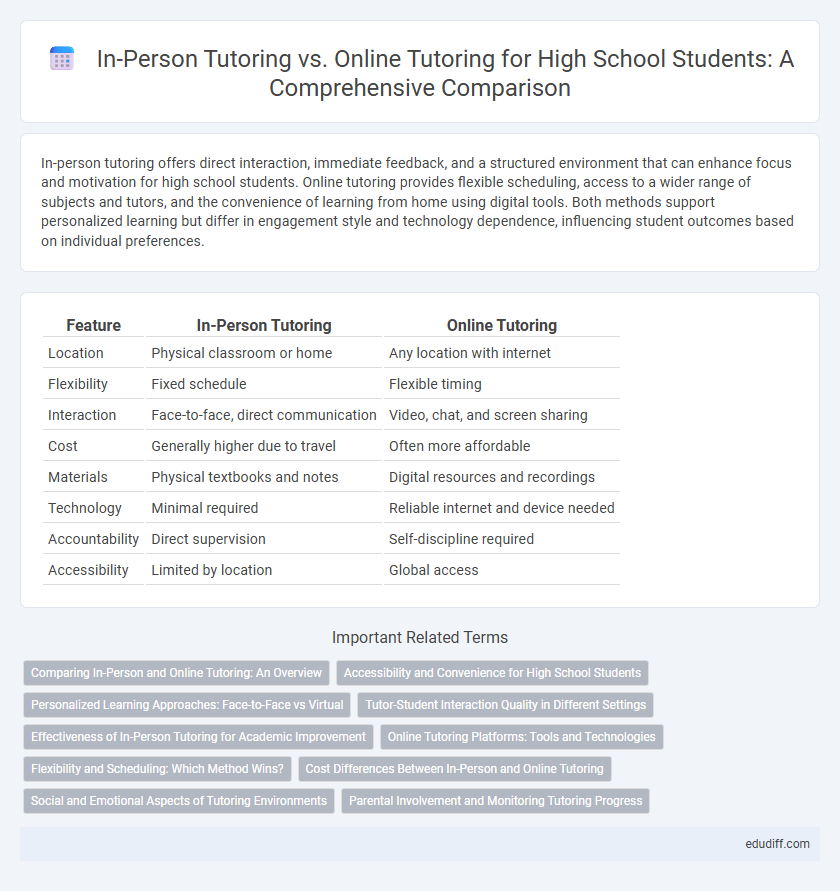In-person tutoring offers direct interaction, immediate feedback, and a structured environment that can enhance focus and motivation for high school students. Online tutoring provides flexible scheduling, access to a wider range of subjects and tutors, and the convenience of learning from home using digital tools. Both methods support personalized learning but differ in engagement style and technology dependence, influencing student outcomes based on individual preferences.
Table of Comparison
| Feature | In-Person Tutoring | Online Tutoring |
|---|---|---|
| Location | Physical classroom or home | Any location with internet |
| Flexibility | Fixed schedule | Flexible timing |
| Interaction | Face-to-face, direct communication | Video, chat, and screen sharing |
| Cost | Generally higher due to travel | Often more affordable |
| Materials | Physical textbooks and notes | Digital resources and recordings |
| Technology | Minimal required | Reliable internet and device needed |
| Accountability | Direct supervision | Self-discipline required |
| Accessibility | Limited by location | Global access |
Comparing In-Person and Online Tutoring: An Overview
In-person tutoring provides direct interaction and immediate feedback, fostering personalized learning environments that help high school students grasp complex concepts effectively. Online tutoring offers flexible scheduling and access to diverse resources, allowing students to learn at their own pace and connect with specialized tutors regardless of location. Both approaches impact academic performance differently, with in-person tutoring benefiting hands-on subjects and online tutoring excelling in accessibility and convenience.
Accessibility and Convenience for High School Students
In-person tutoring offers direct interaction and immediate feedback, fostering deeper comprehension for high school students. Online tutoring provides flexible scheduling and eliminates travel time, making academic support more accessible for students with busy or varied routines. Both methods enhance learning, but online platforms extend access to specialized tutors beyond geographical limitations.
Personalized Learning Approaches: Face-to-Face vs Virtual
In-person tutoring offers immediate, personalized feedback that adapts dynamically to a student's nonverbal cues, fostering deeper understanding through direct interaction. Online tutoring leverages adaptive technology and digital resources to tailor lessons based on real-time performance data, providing flexible and customized learning experiences. Both methods enhance personalized learning, but the choice depends on student preferences for physical presence versus technological integration.
Tutor-Student Interaction Quality in Different Settings
In-person tutoring fosters richer tutor-student interaction through immediate feedback, non-verbal cues, and personalized support, enhancing comprehension and engagement. Online tutoring leverages digital tools like interactive whiteboards and real-time chat, but may face challenges in replicating face-to-face rapport and spontaneity. Research indicates that while both settings can be effective, the quality of interaction in-person often leads to greater academic motivation and deeper understanding for high school students.
Effectiveness of In-Person Tutoring for Academic Improvement
In-person tutoring offers personalized interaction and immediate feedback, which significantly enhances comprehension and retention for high school students. The physical presence of a tutor allows for tailored explanations and hands-on learning, addressing individual academic challenges effectively. Research shows students in in-person settings often experience higher engagement and improved test scores compared to online formats.
Online Tutoring Platforms: Tools and Technologies
Online tutoring platforms leverage advanced tools such as interactive whiteboards, AI-powered adaptive learning, and real-time analytics to enhance personalized instruction and student engagement. These technologies facilitate instant feedback, customizable lesson plans, and seamless communication between tutors and high school students. Equipped with multimedia resources and collaborative features, online platforms create dynamic, effective learning environments that often surpass traditional in-person tutoring capabilities.
Flexibility and Scheduling: Which Method Wins?
In-person tutoring offers fixed schedules that can foster routine and accountability, while online tutoring provides greater flexibility with on-demand sessions accessible from any location. High school students benefit from the adaptability of online platforms, enabling them to balance tutoring with extracurricular activities and varying school hours. Scheduling ease in online tutoring often results in more consistent attendance and personalized learning experiences tailored to the student's unique timetable.
Cost Differences Between In-Person and Online Tutoring
In-person tutoring typically involves higher costs due to expenses such as travel, facility fees, and personalized session settings, often ranging from $40 to $80 per hour. Online tutoring generally offers more affordable rates, averaging between $20 and $50 per hour, as it eliminates travel and physical space costs. Cost efficiency makes online tutoring a popular choice for many high school students seeking flexible and budget-friendly academic support.
Social and Emotional Aspects of Tutoring Environments
In-person tutoring fosters direct social interaction, promoting stronger emotional connections and immediate feedback, which enhance student motivation and confidence. Online tutoring offers flexibility but may limit non-verbal cues and spontaneous peer engagement, potentially impacting emotional support. Understanding these differences helps tailor tutoring approaches to support high school students' social and emotional development effectively.
Parental Involvement and Monitoring Tutoring Progress
In-person tutoring allows parents to directly observe sessions and engage with tutors, enhancing real-time monitoring of their child's academic progress. Online tutoring platforms often provide digital tools such as progress dashboards and session recordings, enabling parents to track performance remotely and access detailed reports. Both methods require proactive communication between parents and tutors to ensure consistent support and timely intervention for high school students.
In-person tutoring vs Online tutoring Infographic

 edudiff.com
edudiff.com